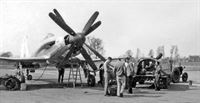Фотографии
-
Регистрационный номер: TS375 [5] This photo of TS375 from the rear highlights the Youngman flaps, seen extended in the “cruise” setting. This type of flap had proved itself on the wartime Fairey Barracuda and Firefly, acting as a slotted flap for take-off and landing or as an auxiliary aerofoil to increase wing area and efficiency to extend endurance in cruising flight.
Самолёты на фотографии: Westland Wyvern - Великобритания - 1946
-
Регистрационный номер: TS375 [5] The second Westland Wyvern prototype, TS375, has its Rolls-Royce Eagle sleeve-valve engine run up at RNAS Merry field, a satellite of RNAS Yeovilton, around the time of its first flight in September 1947. The noise from the massive powerplant and its eight-bladed contra-rotating propeller must have been deafening, and at least two of the bystanders are, quite sensibly, covering their ears!
Самолёты на фотографии: Westland Wyvern - Великобритания - 1946
-
A different Wyvern and possibly a different location - the aircraft is probably the third or fourth of the original six prototypes. Of the Eagle-powered machines, only TS378 and TS380 appear to have worn the post-war Admiralty colour scheme of Extra Dark Sea Grey over Sky as seen here in this group shot. The location is hard to establish, although it may be Merry field or even Rolls-Royce’s aerodrome at Hucknall. The gentleman in the white shirt and spectacles is believed to be Dennis Edkins, Wyvern designer Teddy Petter’s assistant.
Самолёты на фотографии: Westland Wyvern - Великобритания - 1946
-
Регистрационный номер: TS375 [5] Seen here from the front in “clean” configuration, with flaps retracted, TS375 did not have folding wings or any armament fitted; the first two prototypes were purely aerodynamic and systems test vehicles. The first prototype, TS371, was lost in a fatal crash little more than a month after TS375 first flew.
Самолёты на фотографии: Westland Wyvern - Великобритания - 1946
-
Регистрационный номер: TS375 [5] As Westland’s factory at Yeovil was not suitable for the Wyvern’s early test flights, much of its development flying was undertaken from Merryfield. Here we see TS375 in front of a T2 hangar, with engineers working on the complex Rotol propeller. Only the rear blades are yet in place; the apparatus to lift the front blade unit into place may be seen to the left.
Самолёты на фотографии: Westland Wyvern - Великобритания - 1946
-
Регистрационный номер: TS375 [5] With a strap placed around its rear fuselage. TS375 is prepared for a tethered engine test run. Only a few early test Eagles had been built before 15 examples of the 3,500 h.p. Eagle 22 were produced by Rolls-Royce, largely for the Wyvern test programme. The prominent gills in the forward part of the cowling are the outlets for hot air passing over the intercoolers, which were arranged in a semi-annular fashion around the reduction gear.
Самолёты на фотографии: Westland Wyvern - Великобритания - 1946
-
The test crew assembles for the tethered engine run, and the Wyvern is fuelled from a small Brockhouse-type bowser. The battery trolley has also been plugged in. Note the square carburettor intake under the nose, wedged between the annular intercooler intakes, and the staining along the forward fuselage from the exhaust.
Самолёты на фотографии: Westland Wyvern - Великобритания - 1946
Статьи
- -
- A.Delalande - All the president's men
- C.Gibson - What is Rechlin 104? Germany's mystery cargo aircraft
- C.Higgs - Proof positive
- E.Bryan - A lot less bother by hover!
- L.Gaylard - The fall of Damien
- M.Bearman - Tunnel vision
- M.Willis - "Very nearly a good aeroplane..."
- N.Stroud - Off to Butlin's /The John Stroud Archive/
- P.Davidson - Off the Beaten Track...
- P.Jarrett - Lost & Found
- P.Jarrett - Sidney Camm's long-lost triplane
- R.Lezon - The Walrus in Argentina
- R.Mulder - Crossing the Deep
- R.Riding, A.Stephenson - What a woman! Janet Ferguson: ferry pilot extraordinare
- T.Buttler - TSR.2's company: Hawker P.1129






